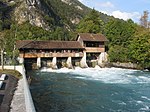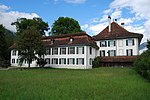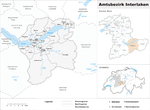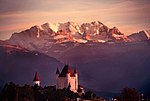Unterseen

Unterseen is a historic town and a municipality in the Interlaken-Oberhasli administrative district in the canton of Bern in Switzerland. Unterseen literally means Lower Lake, which is correct, since Unterseen is located on the flat area on the eastern shore of Lake Thun between the two creek Lombach below the Chienberg to the north and the Aare to the south, which both flow into Lake Thun. The historic town however is mainly found at the northern bank of the Aare, which flows here from Lake Brienz to Lake Thun (therefore lower lake). Just across the Aare is the town of Interlaken. Both municipalities are located on the flat alluvial land among steep mountains, which is also called the Bödeli. Unterseen belongs to the Small Agglomeration Interlaken with 23,300 inhabitants (2014).Along with Interlaken, Unterseen is an important tourist center in the Bernese Highlands, and from the town one can see the mountains Eiger, Mönch and Jungfrau.
Excerpt from the Wikipedia article Unterseen (License: CC BY-SA 3.0, Authors, Images).Unterseen
Spielhölzli,
Geographical coordinates (GPS) Address Nearby Places Show on map
Geographical coordinates (GPS)
| Latitude | Longitude |
|---|---|
| N 46.683333333333 ° | E 7.85 ° |
Address
Spielhölzli 7
3800
Bern, Switzerland
Open on Google Maps











